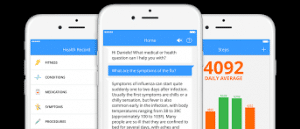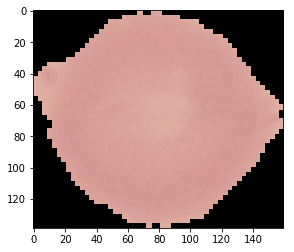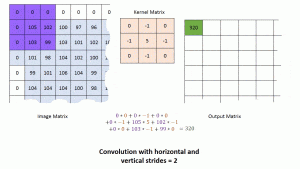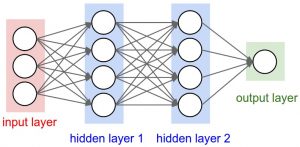Among multiple areas like customer analytics, finance, marketing, AI has shown a great promise in the healthcare domain. There has been increasing support towards using AI by both, the industry and the academia. In the following blog, we discuss 4 areas in which AI has helped the healthcare industry. As a bonus, for all the techies who like to get their hands dirty, we have included a practical tutorial for you to build your own malaria detection algorithm.
###
Virtual Assistants
Healthcare industry is massively investing in intelligent systems in order to make their services more efficient. One such way is by developing Medical Virtual Assistants. The assistants, supported by AI enable smooth and quick interaction not only with patients about frequently asked questions but also with doctors who might want to retrieve medical information or the history of a patient. According to a study, 49% of a physician’s time is spent doing administrative work. Something that can be largely automated using IT.
Using Machine Learning and Natural Language Processing techniques, it becomes extremely convenient to navigate through medical databases in order to get the desired information. In addition, these assistants are able to deliver personalized notes to a patient by analyzing their medical information and history. It is estimated that the virtual assistant market will reach $15.8 B in 2021 from $1.6B in 2015. Nuance, a company founded in 1992 claims that its virtual assistant is helping doctors serve patients better automating a doctor’s schedule for the day, patient’s problems, his/her summary and much more.

CT Scans
Repetitive tasks like analyzing X Rays and CT scans can and have been made easier and less time consuming by AI. A 2016 startup qure.ai claims to be making an interpretable deep learning algorithm to analyze X Rays. According to them, head CT scans are the first line diagnostic modality for patients with head injury or stroke. One of their products, qER is designed for triage or diagnostic assistance in this setting. The most critical scans are prioritized on the radiology worklist so that they can be reviewed first.

Radiology
Radiology, another field in healthcare has been shown to benifit immensly from AI. Doctors and AI engineers found that technologies like Deep Learning can help radiologists in multiple ways. Application of deep learning like autoencoders can help improve the image quality by ‘repairing’ the pixels. It can also help detect lesions (a region in an organ or tissue which has suffered damage through injury or disease, such as a wound, ulcer, abscess, or tumour) that may be subtle. This can be useful when the radiologist is tired or exhausted, which is very often the case. Although there have been arguments that AI algorithms will eventually surpass human accuracy, experts say that in fact the opposite would occur. These intelligent applications will help humans gain a deeper and better understanding of the process.
Drug Design
AI has shown immense potential to help pharmaceutical industries, especially in their Research and Development process, particularly in the areas like predicting treatment results, drug design and data preprocessing. On the research side, algorithms like Convolutional Neural Networks have levelled up the process of drug design. A company named Atomwise developed a technology named AtomNet technology that enables researchers to combine atoms virtually to come up with possible molecules. The company claims that their algorithm is trained to process and analyze billions of atoms to find which ones will bond, and will then simulate their testing on the computers.
GANs or Generative Adversarial Networks are a class of networks that generate images that are real looking. pharm.ai , a project by Insilico medicine uses these GANs and reinforcement learning to generate new molecular structures and to find the biological origin of a disease. lnsilico uses AI to help pharmaceutical companies improve the R&D processes, develop companion diagnostics and improve clinical trials enrollment practices. The company claims to collect the human tissue of young, middle-aged, old, and very old patients to build its own data, which can be used to train other datasets.
Case Study
For those of you who would like to have a hands-on experience of how these technologies work, we have created a program to check if a microscopic image of a cell is infected by malaria or not using a simple Convolutional Neural Network or a CNN
Code link – https://github.com/DhruvilKarani/Malaria-Detection-using-pytorch
Dataset – https://www.kaggle.com/iarunava/cell-images-for-detecting-malaria/kernels
Dependencies to be installed – torch, torchvision, pandas, NumPy (for torch and torch vision, follow this link https://stackoverflow.com/questions/51730880/where-do-i-get-a-cpu-only-version-of-pytorch)
Consider an image of an uninfected and parasitized cell –
An uninfected cell

A parasitized cell

As we can see, the parasitized cell varies from the uninfected cell by the presence of a purple substance. Our objective is to train a classifier to distinguish infected and uninfected cells.
In our dataset, we have in total 27,558 images. The infected and uninfected images are distributed equally.
For those of you not familiar with CNNs, we’ll understand it very intuitively. Essentially, there are two main parts in a CNN
-
Convolutional filters
-
Fully connected layers
Convolution filters are like eyes. They capture details or features in an image. For example, in the case of a flower, they capture complex features about the shape, colour, etc. These features are captured by sliding a window called a convolution filter over an image.

Then these features are passed on to the fully connected layers. Fully connected layers process these features. This network comprises many connections among unit cells or neurons. The final output is used to predict the class.

Using the pytorch framework available in python, we train a model and then test it on a validation set. Here are our results:

Our accuracy on this set is 93% on an average which is great for a simple network.